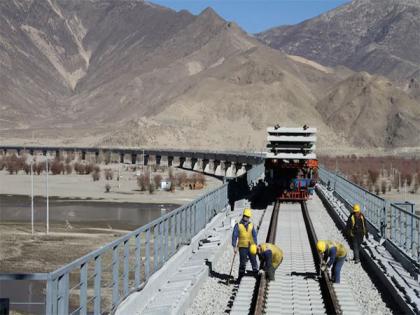Tibet's Yarlung Zangbo Dam: China's new tool for environmental destruction, Brahmaputra domination
By ANI | Updated: August 2, 2025 18:54 IST2025-08-02T18:48:02+5:302025-08-02T18:54:41+5:30
Beijing [China], August 2 : China has begun construction on what it claims will be the world's largest hydropower ...

Tibet's Yarlung Zangbo Dam: China's new tool for environmental destruction, Brahmaputra domination
Beijing [China], August 2 : China has begun construction on what it claims will be the world's largest hydropower project, the Motuo Hydropower Station, deep in the politically sensitive region of Tibet. Costing an estimated USD 170 billion and projected to generate 300 billion kilowatt-hours of electricity annually (roughly the amount consumed by the UK in a year), the dam is raising serious alarm across South Asia.
According to The Institute for Energy Research (IER), the Motuo project will consist of five cascade hydropower stations in the lower reaches of the Yarlung Zangbo River, which becomes the Brahmaputra once it crosses into India and then Bangladesh. This gives Beijing direct control over a vital transboundary river that supports millions downstream and effectively hands China a dangerous new geopolitical weapon.
A 2020 report by the Lowy Institute, cited by IER, warned that "control over these rivers effectively gives China a chokehold on India's economy." Experts now fear the Yarlung Zangbo could be used as a "water bomb," either draining the Brahmaputra during dry seasons or triggering devastating floods in India's Arunachal Pradesh and Assam states. Indigenous groups like the Adi tribe, who rely on the Siang River, one of the Brahmaputra's upper tributaries, stand to lose everything.
The local ecosystem in the region, among the richest in the Himalayas, could be irreversibly damaged. Both India and Bangladesh have voiced formal concerns, with India reportedly exploring a countermeasure: a buffer dam on the Siang to offset sudden Chinese water discharges.
IER notes that for China, this mega-project is about more than electricity. It serves Beijing's wider goals of industrialising Tibet and exporting power eastward to China's urban centres under the "xidiandongsong" policy, literally, "sending western electricity east." But activists and Tibetans see a darker motive: exploitation masked as development.
Just last year, hundreds of Tibetan protesters were rounded up, beaten, and arrested for opposing another hydropower station.
Despite China's climate pledges of a carbon peak by 2030 and net-zero by 2060, IER argues the Motuo Dam is less about clean energy and more about strategic leverage. With glacial melt driving the river's flow, seasonal variability could undermine energy output. Still, Beijing appears undeterred, treating the project more as a geopolitical instrument than an environmental solution.
As IER concludes, the Motuo dam exemplifies China's readiness to weaponise water, putting regional security, ecological balance, and human rights at grave risk.
Disclaimer: This post has been auto-published from an agency feed without any modifications to the text and has not been reviewed by an editor
Open in app